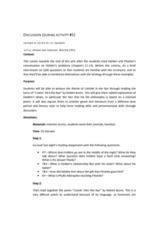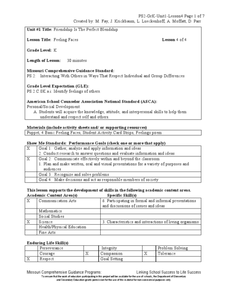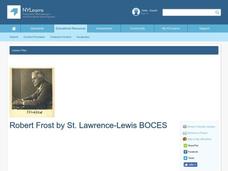College Board
2009 AP® English Literature and Composition Free-Response Questions
Scholars select a novel or play and craft an essay to discuss what the symbol reveals about the characters or theme. Writers also analyze a passage and a poem to determine how the authors use literary elements to relay their messages.
College Board
2010 AP® English Literature and Composition Free-Response Questions
Three free-response prompts provide scholars an opportunity to practice for the AP® English Literature Composition exam. Using released prompts from the 2010 free-response section, writers craft an essay about the experiences of a...
KERA
Matisse and Picasso
Discover Modernism through the eyes of artists. Over the course of six well-thought-out lessons, learners examine works by Pablo Picasso and Henri Matisse while completing a range of collaborative and hands-on activities. A great resource!
Curated OER
Focus on Figurative Language
Using the poems "First Snow" by Ted Kooser and "Eating Alone" by Yi-Young Lee (or other suggested poems by Robert Frost or Sara Teasdale), middle schoolers search for examples of figurative language. Guide your learners by discussing...
Curated OER
Candles in the Dark
Students analyze and apply their personal responses through poetry and film to a challenging and disturbing event-the Holocaust. They use a digital video camera to film each student reading their poem.
Curated OER
Literary Response and Analysis
Examine a variety of literary responses to Abraham Lincoln's death and the impact of perception. Your class can work in writing groups to analyze either poetry, eulogy, or a newspaper article. They retell the events of Abraham Lincoln's...
Curated OER
African Americans in the Civil War
Eleventh graders examine the role of African-Americans in the Civil War. After reading a poem, they analyze and identify the difficulties faced by African Americans. In pairs, they complete a worksheet based on the poem and information.
Curated OER
Hermeneutics: Teaching Students Author's Purpose
Your developing literary critics discuss 'perspective' and discuss how the same occurence can be interpreted by two different people in two different ways. They read Ryszard Kapuscinski's untitled poem, infer meaning of the poem, and...
Curated OER
The Catcher in the Rye: Chapters 21-23
After answering comprehension questions (good for a homework reading check), class members analyze "Comin' Thro the Rye," and using the included guidance questions, discuss Holden's misreading of Robert Burns' poem. The URL to text of...
Curated OER
Comparing Themes Across Texts
Read various texts to compare the themes across each text. Learners write a journal entry describing the most beautiful scenery they've seen and use a map of the United States to locate the Sequoia National Park and Muir Woods. They then...
Poets.org
Ghosts and Spirits
Connect poetry to a naturally kid-friendly topic: ghosts! Draw on your class's prior knowledge of the paranormal to help them access the classic poem "Haunted House" by Henry Wadsworth Longfellow. After a fun warm-up activity describing...
Curated OER
Not Only Paul Revere: Other Riders of the American Revolution
Middle schoolers examine circumstances surrounding rides of the American Revolution other than Paul Revere's, explore why posterity treated them differently than Revere's ride, and create original poems based on historical fact.
Curated OER
Feeling Faces
Students explore their feelings. They listen to poems for emotions and complete the basics feelings activity sheet.
Curated OER
Robert Frost
Start your poetry unit with this basic overview of Robert Frost's life and works. A PowerPoint presentation starts off the instructional activity, which ends in a short recall quiz about Robert Frost. The presentation would be sufficient...
Curated OER
Presentations Come Alive!
Partners create oral presentations about a short story or poem incorporating audiovisual aids. Then they make presentations to their classmates. Linked story map will help guide readers' organization of their presentation;...
Curated OER
Introducing Communication Talent with "Casey at the Bat"
Analyze the poem "Casey at the Bat." Your team of analysts will read the poem and complete a variety of activities, including describing how Casey looks and acts, describing how he feels before and after he strikes out, and sharing...
Curated OER
What is Good Use of Time?
Students analyze the best uses of time in other cultures. In this time use lesson, students read the poem 'Soccer Into Dusk' and 'The Meaning of Time' as analysis of time usage in other culttures. Students complete a discussion, journal...
Curated OER
I've Just Seen a Face: Portraits
Students examine portraits for different images they project, cite three purposes a portrait can serve, analyze portraits of historical figures, and relate biographical research to portraits.
Curated OER
Sea Changes: A New England Industry
Students conduct research in order to use primary and secondary sources. They interpret and analyze information from textbooks and nonfiction books for young adults, as well as reference materials, audio and media presentations, oral...
Curated OER
Tales of Edgar Allen Poe
Analyze the writing of Edgar Allen Poe by reading and then writing in a similar style. Budding authors learn about the life of Poe and read one or more of his famous works online. Partner groups create an original piece of writing using...
Curated OER
A Lifetime of Service
Students research Peace Corp volunteer Mary Ann Camp. In this Peace Corp research lesson, students research analyze Camp's roles in the Peace Corp. Students research Mary Ann's Peace Corps work and watch a video about Mary Ann's Peace...
Appalachian State University
Making Your Point Using Dialect
Explore the sounds, importance, and effectiveness of dialect in literature. Active participants read, listen to poetry, and explore dialect by developing a formal definition, discuss the benefits of its use, complete a Venn diagram and...
Curated OER
Note Taking
Third graders get ready to take notes on a field trip. In this notetaking lesson, 3rd graders take notes to remember what they've seen on a field trip. Students draw and analyze diagrams of what they have seen. Students access their...
Shmoop
ELA.CCSS.ELA-Literacy.L.11-12.5
"Timid, scared, terrified." High school scholars examine words, their denotations and connotations, in a series of exercises that use lines from Shakespeare to explore figurative language and word relationships. Participants then...
Other popular searches
- Analyze Poetry
- Analyze Poetry Third Grade
- Analyze Symbolism in Poetry
- How to Analyze Poetry
- Analyze Imagery in Poetry

























